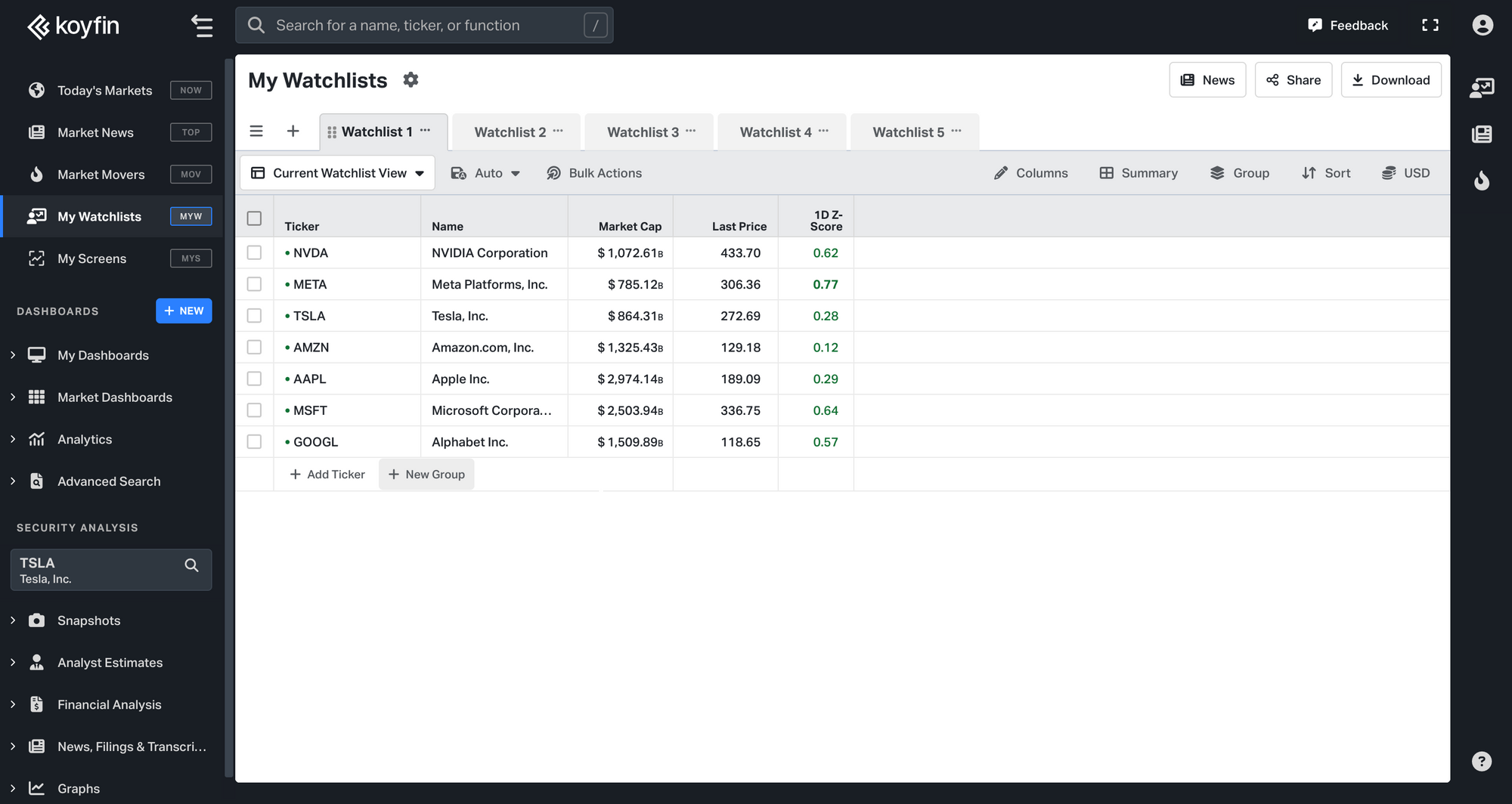Altman Z Score
The Altman Z score determines the chances of bankruptcy for a company. Typically a lower, or declining, score indicates a higher risk of bankruptcy.
We show the Altman Z Score using the average stock information for a period data-field. The example below shows the calculation for Apple Inc. as of January 28, 2022.
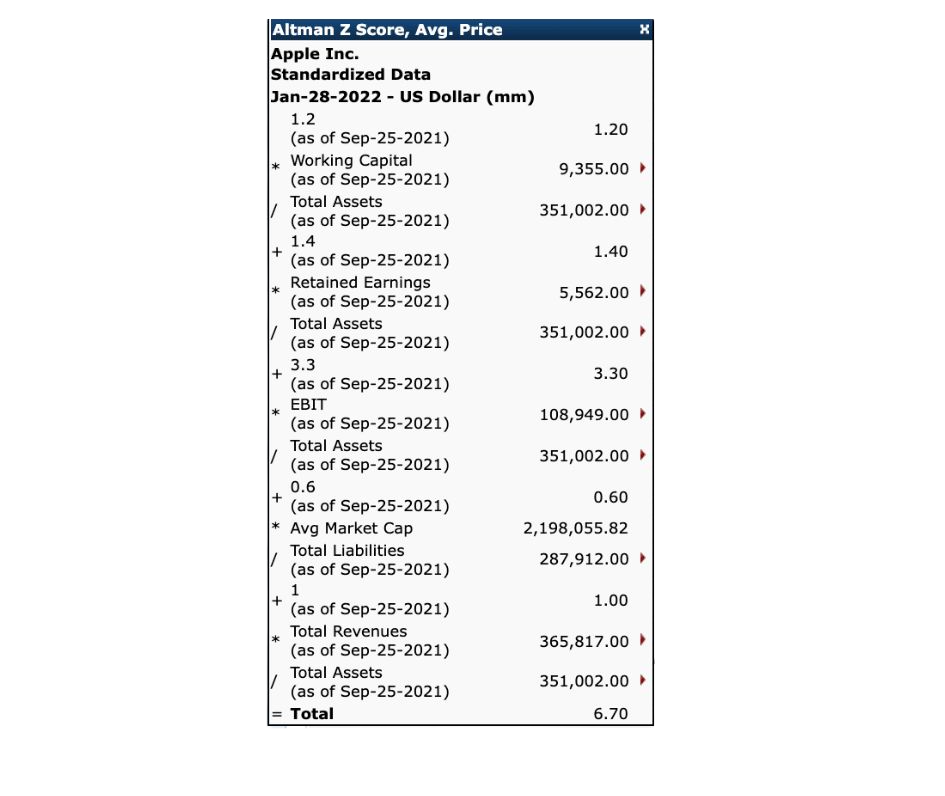
Beta
Beta is a measurement of the sensitivity of a company stock price to the overall fluctuation of a given benchmark index. Betas are levered, unadjusted and derived from a least squares regression analysis using stock and benchmark index returns based on a monthly or weekly frequency. Beta in the watchlist and screener is calculated using 60 monthly returns (each as of month end) but if the company trading history is too short to provide such a sample, fewer than 60 but not fewer than 24 monthly returns are used to run the regression.
The benchmarks are the S&P 500 for all U.S. stocks, the S&P/TSX Composite for all Canadian stocks, the MSCI EAFE for all developed market stocks in Europe, Australasia, and the Far East, and the MSCI Emerging Markets for all other international stocks.
If you want to graph Beta for a particular stock, you can use the G chart on Koyfin. The default window in the chart is 1 year (252 days), and you can specify this value in the Beta settings.
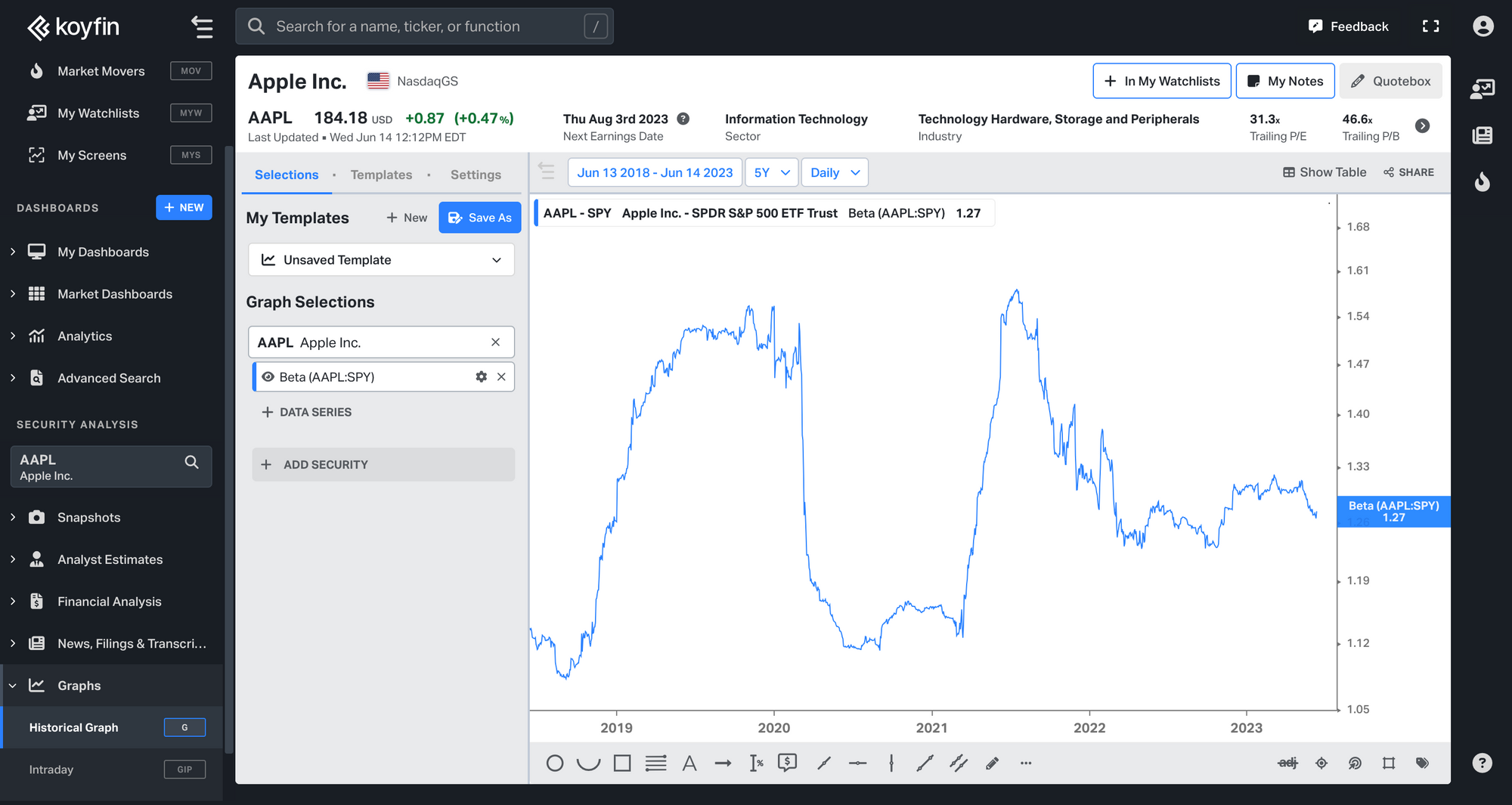
Book Value/Share
Book Value / Share is a ratio calculated using the following formula:
Book Value/Share = Total Common Equity / Total Shares Out. on Balance Sheet Date
The example below is for Apple Inc. as of September 25, 2021.
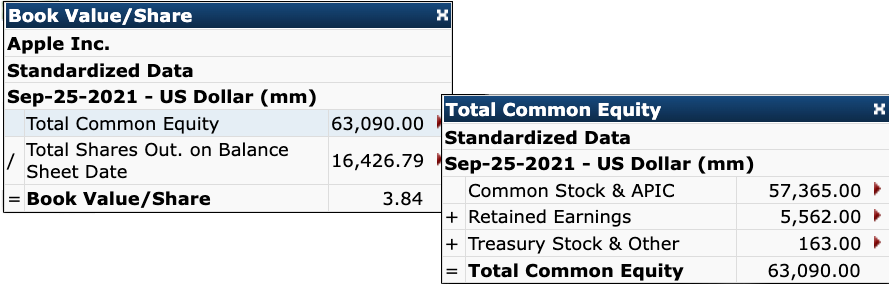

Buyback Yield %
Buyback Yield is the repurchase of outstanding shares over the existing market cap of a company. It is calculated using the formula:
Buyback Yield = ((Issuance of Common Stock + Repurchase of Common Stock) / Latest Market Cap)
You can visualize the Buyback Yield of a company in the G chart. For example, the graph below shows the Issuance of Common Stock, Repurchase of Common Stock, Latest Market Cap, and Buyback Yield for Apple Inc.
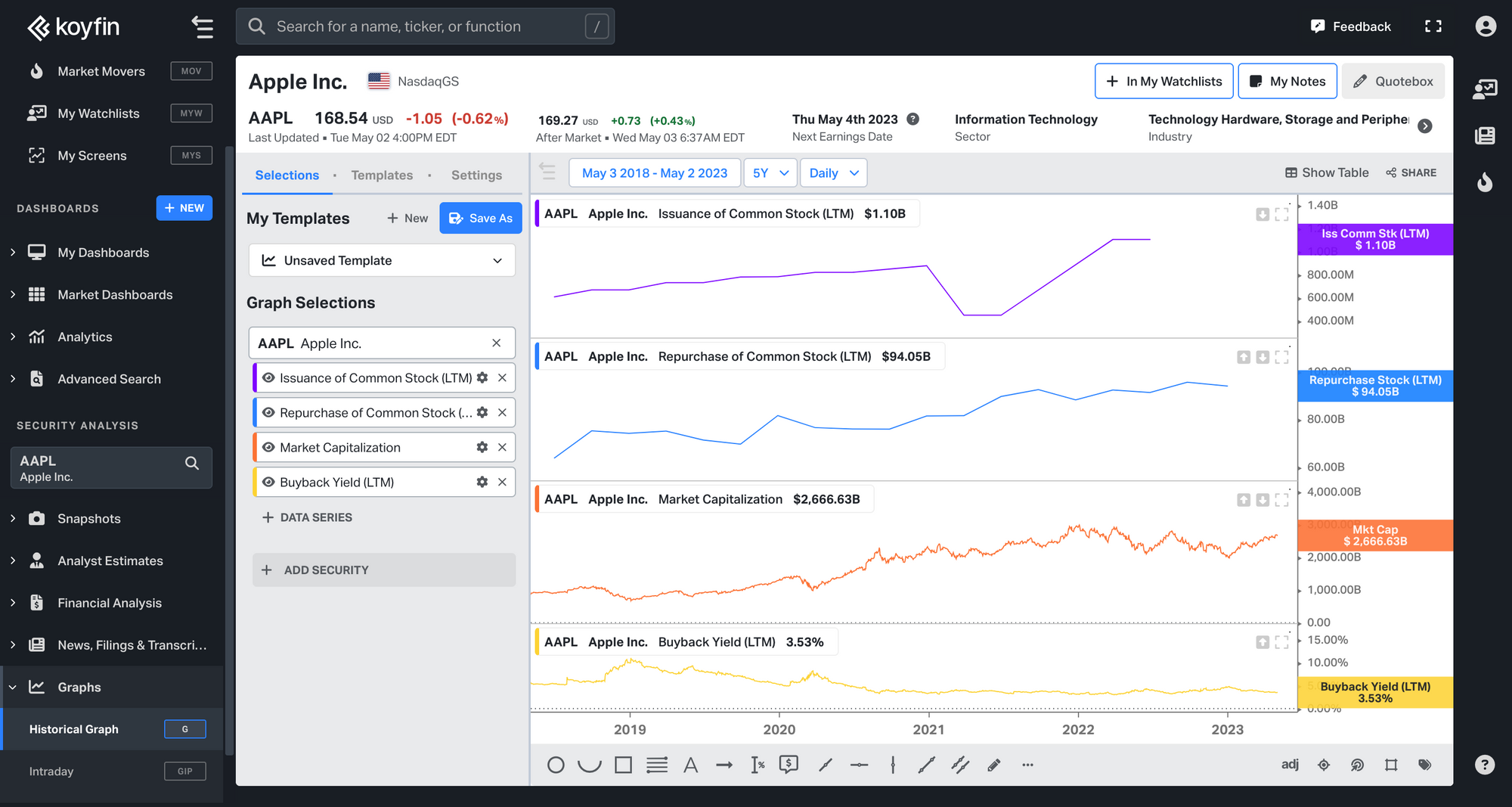
Debt Paydown Yield %
Debt Paydown Yield is equal to the net change in long-term debt over the trailing twelve months period divided by the company's market capitalization. It is calculated using the following formula:
Debt Paydown Yield = ((Total Debt Issued - Total Debt Repaid) / Latest Market Cap)
You can find the Debt Paydown Yield for a company on the Dividend Snapshot page.
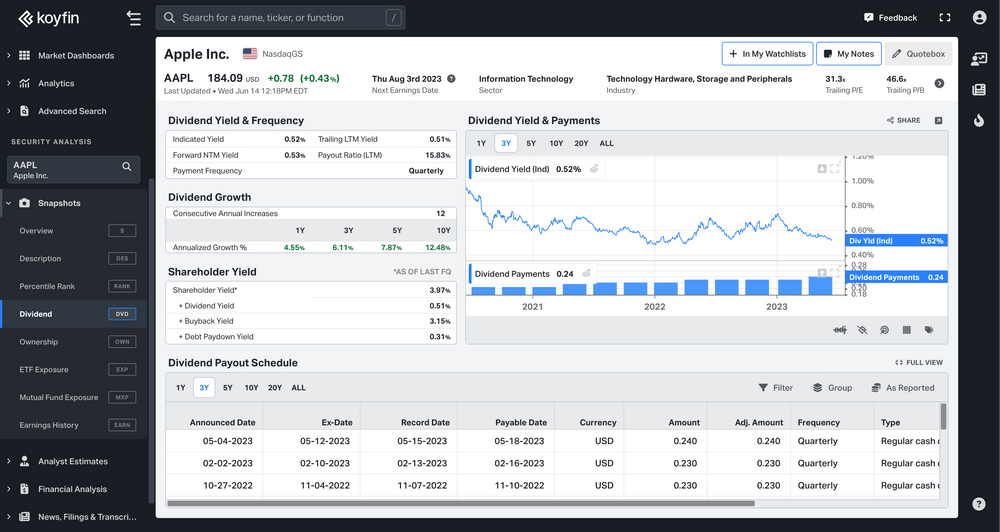
Diluted EPS - Continuing Operations
This is the most common EPS value used by investors which excludes extraordinary items.
This is a GAAP EPS value and includes options expenses and other accounting adjustments. It is calculated using the following formula:
Diluted EPS Continuing Operations = Diluted Net income / Diluted Weighted Average Shares Outstanding
The example below shows the calculation for Apple Inc. as of September 24, 2022.

Dividend Yield %
We use the following formula to calculate the Dividend Yield:
Dividend Yield = (Dividend amount / Last Price)
There are four types of Dividend Yield:
- Indicated (IND) - the annualized dividend yield based on the latest dividend payment.
- Trailing-twelve-months (TTM) - the dividend yield based on the latest 12 months of dividends, including special dividends.
- Last-twelve-months (LTM) - the dividend yield based on the latest 12 months of dividends, excluding special dividends.
- Next-twelve-months (NTM) - the dividend yield based on the consensus mean forward 12 months of dividends.
Here's an example graph of the different types of Dividend Yield for Apple Inc.
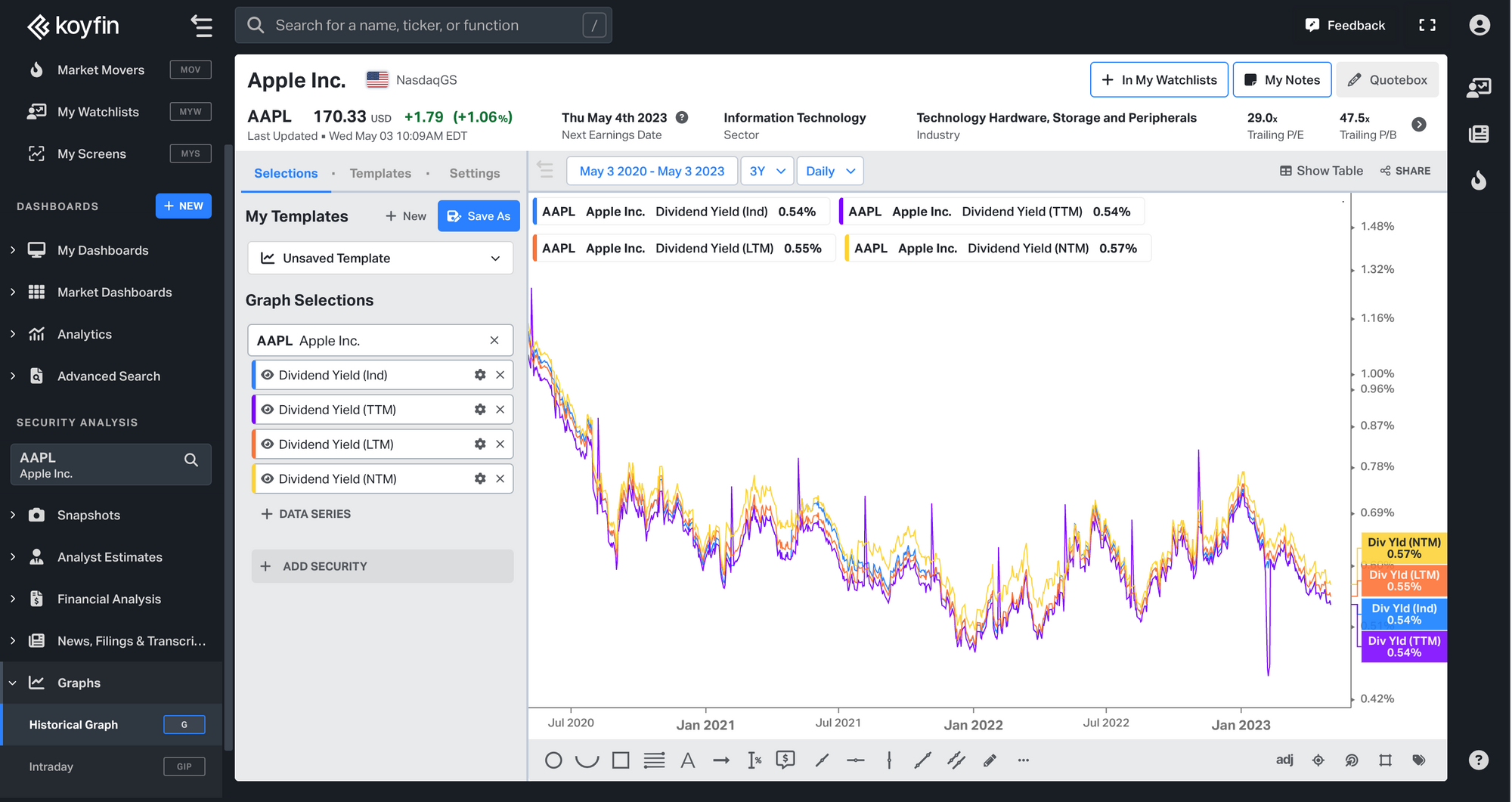
EBIT
EBIT is Earnings before interest and taxes, and is equal to Operating Income.
The example below shows the calculation for Apple Inc. as of September 25, 2021.
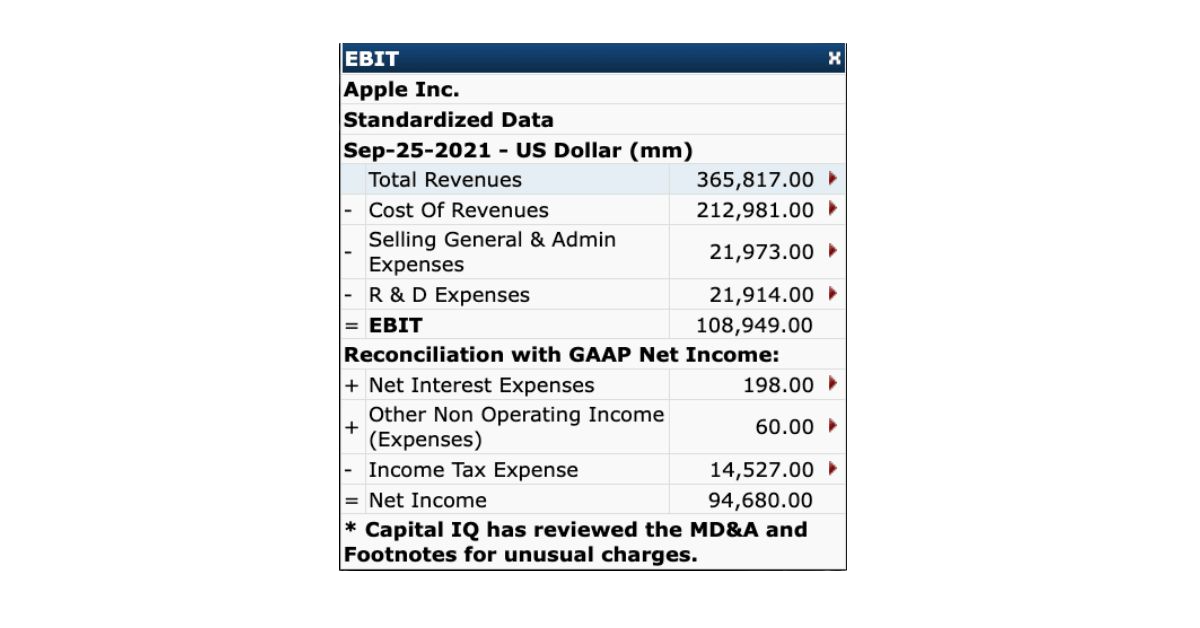
EBITDA
EBITDA, or Earnings before interest expense, taxes, depreciation and amortization, is a financial metric used to evaluate a company's profitability.
Starting in 2019, EBITDA was adjusted for leases as per FASB rules. For more information on this topic, please refer to this article. The example below shows the calculation for Apple Inc. as of September 25, 2021.
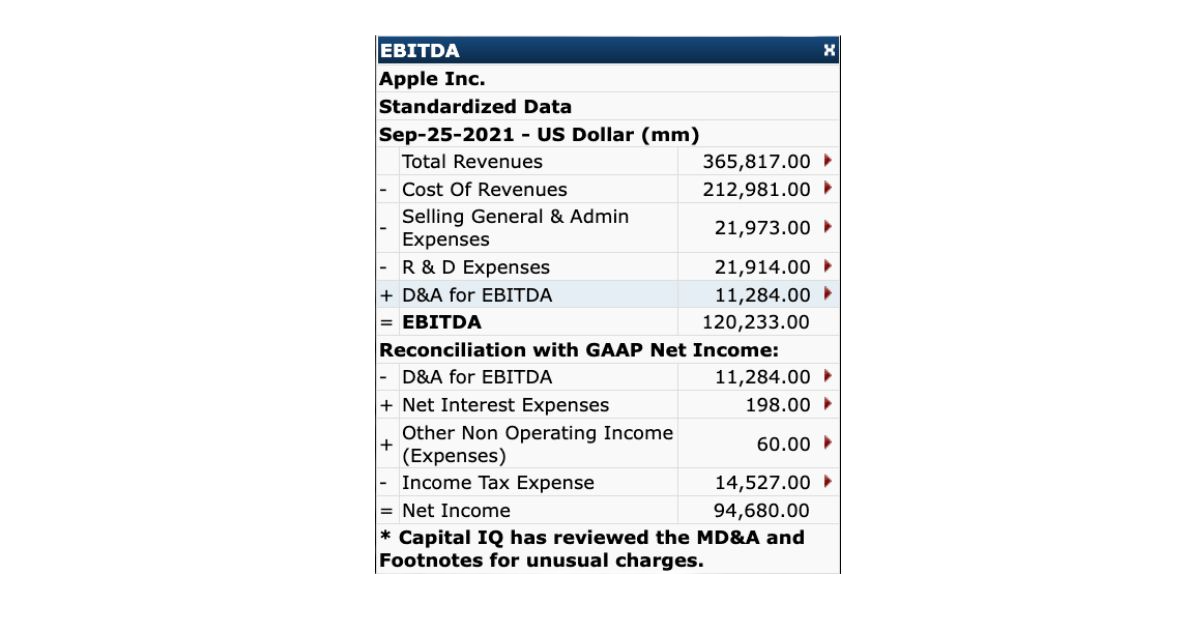
EBITDA / Interest Expense
The interest coverage ratio shows the ability of a firm to meet its interest expenses.
The example below is for Apple Inc. as of September 24, 2022.
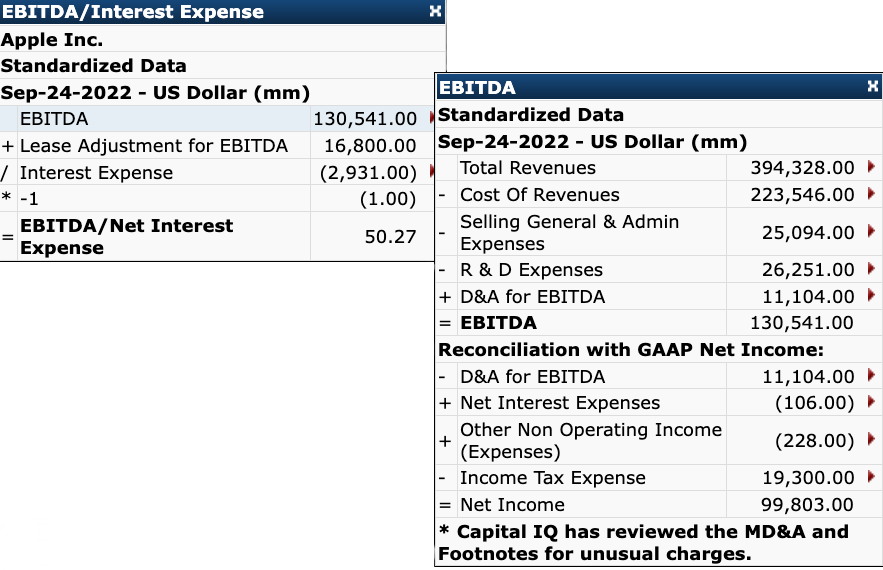

Enterprise Value
Filing Date Total Enterprise Value represents the cash-less value of a firm as an asset as of the filing date of the balance sheet period end date.
To calculate the Filing Date Market Capitalization, we use the following formula:
Filing Date MarketCap = Book Value of Total Debt + Book Value of Preferred Stock + Book Value of Minority Interest - Cash & Short Term Investments
The example below is for Apple Inc. as of May 3, 2023.

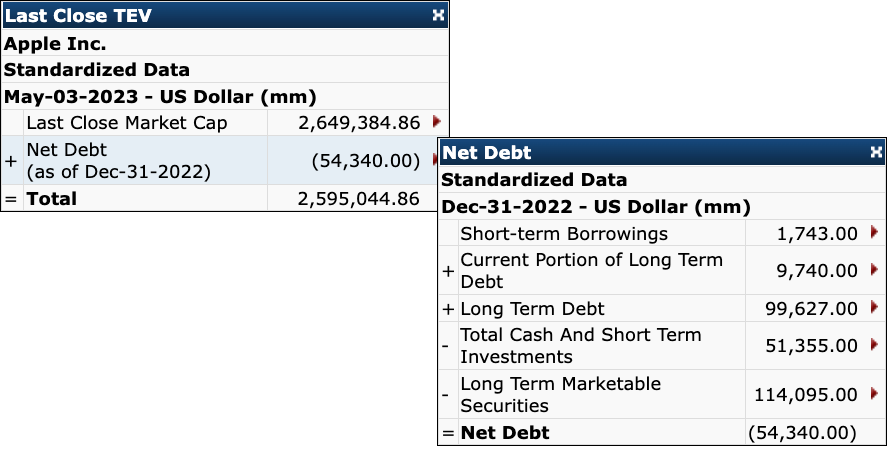
EV/EBITDA
We use the following formula to calculate the EV/EBITDA ratio:
EV/EBITDA = Last Close Total Enterprise Value / EBITDA (including equity from affiliates and adjusted for lease expenses)
The example below shows the calculation for Apple Inc. as of November 11, 2021.

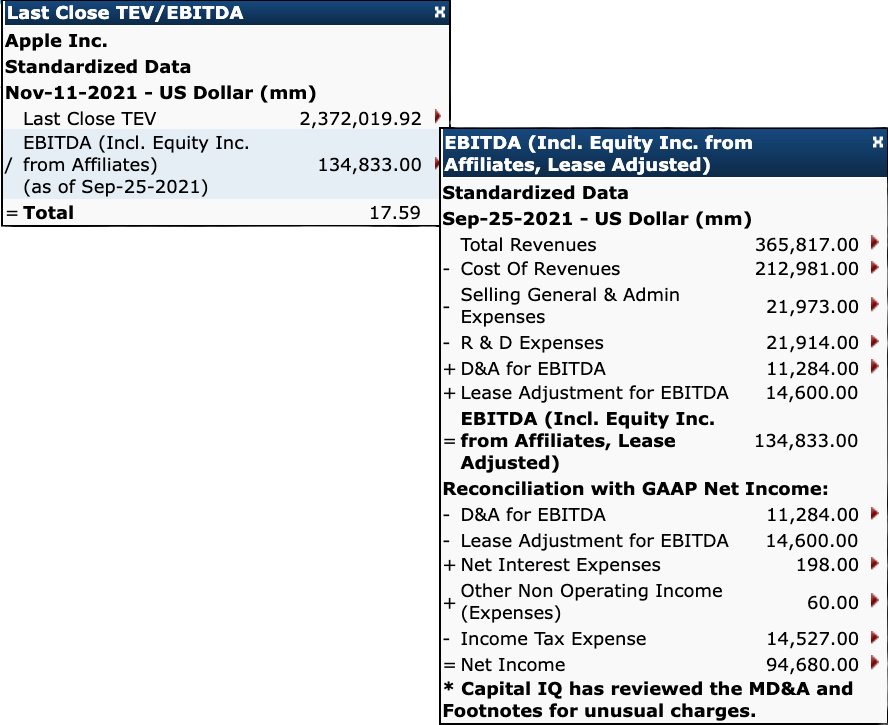
Free Cash Flow
The formula for Free Cash Flow is FCF = Cash Flow from Operations - Capex. You can visualize the Free Cash Flow of a company using the G chart.
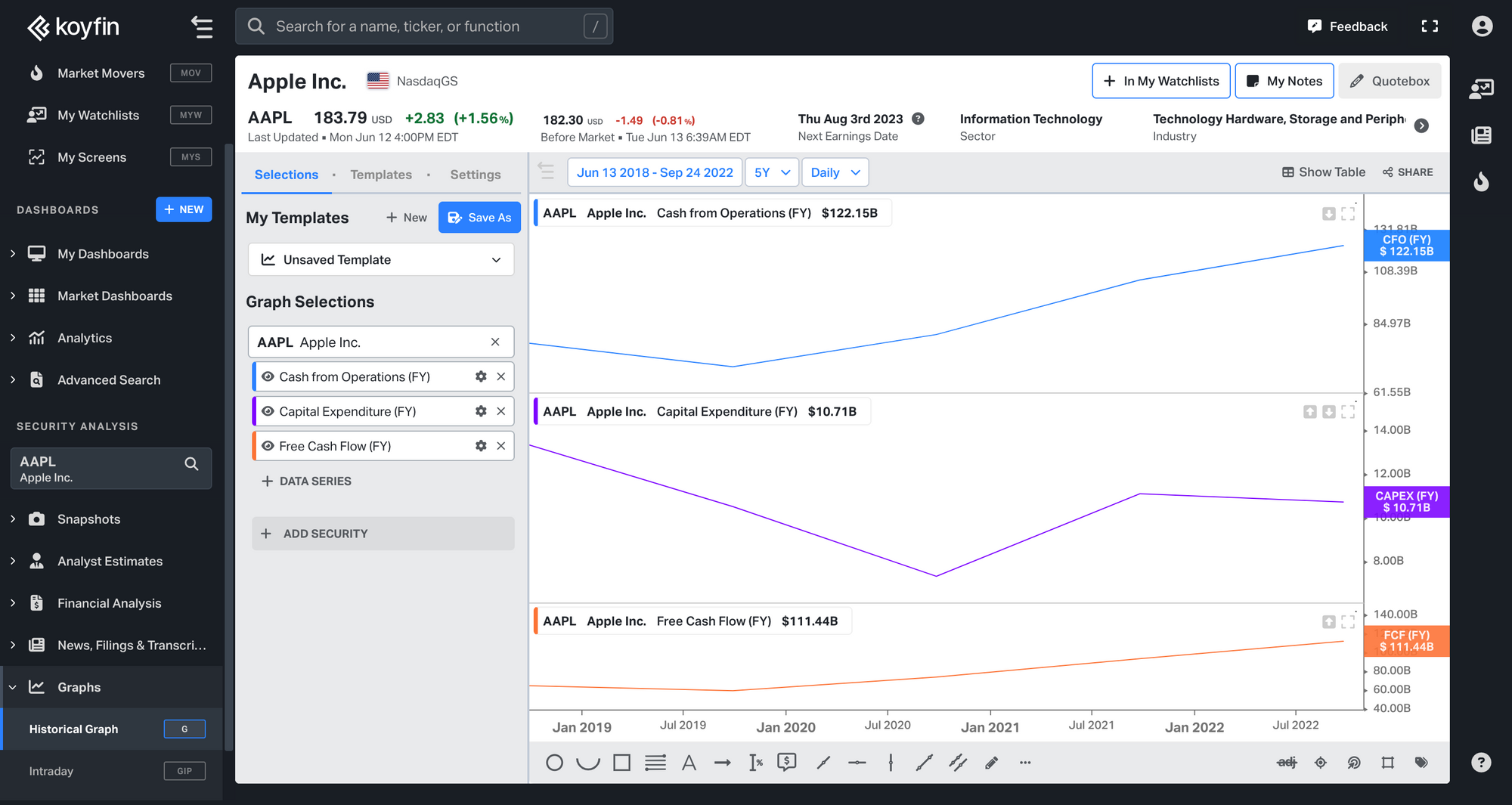
Free Cash Flow EV Yield %
To calculate the Free Cash Flow EV Yield, we use the following formula:
FCF EV Yield = FCF / EV
You can view a graph of Apple Inc.'s Free Cash Flow EV Yield over the past 5 years on Koyfin.
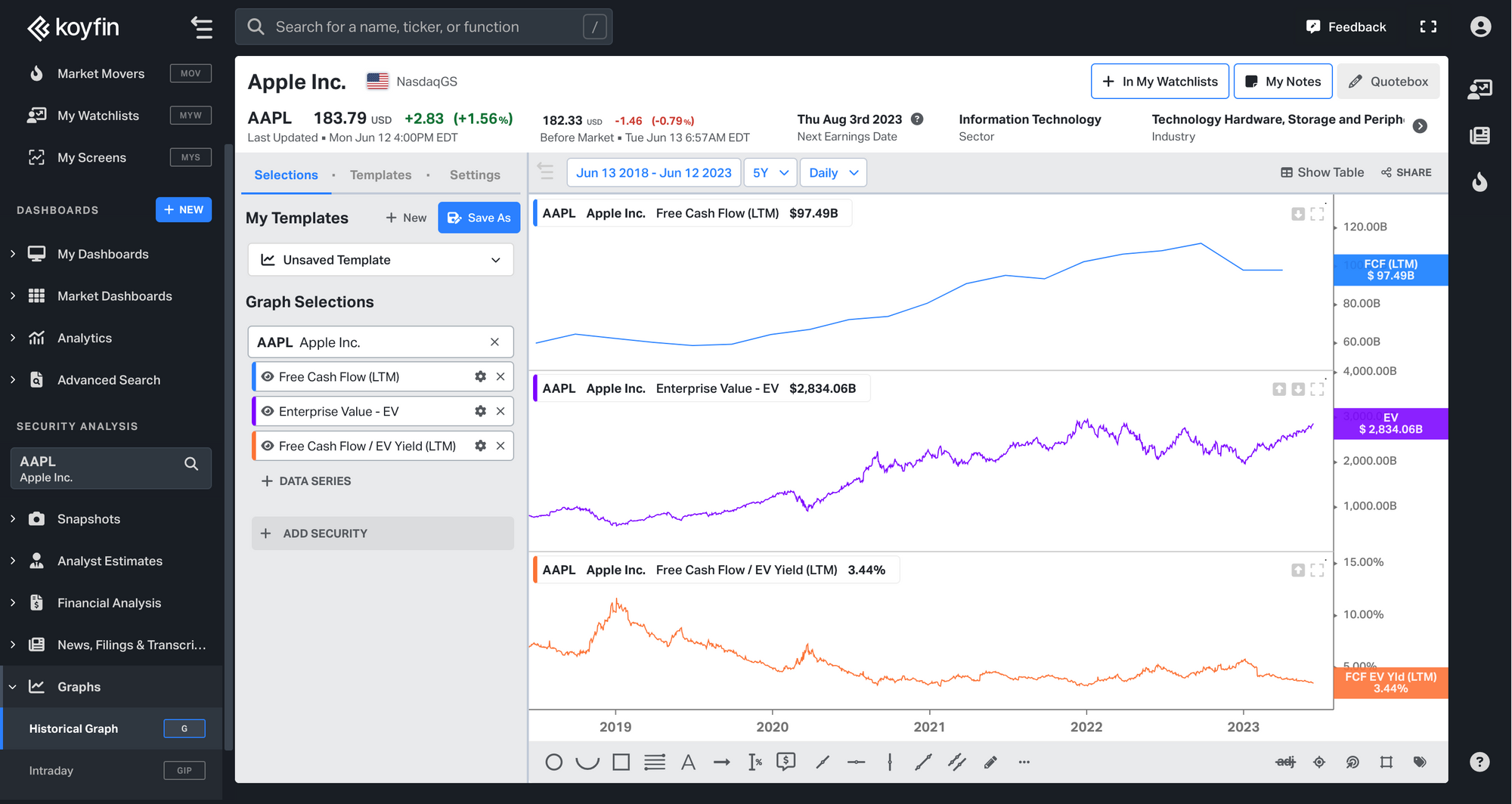
Free Cash Flow per Share
We calculate Free Cash Flow per Share ourselves using Free Cash Flow / Shares Outstanding.
You can see how Apple Inc. has performed over the past 10 years by looking at the Free Cash Flow per Share of AAPL in the G chart.
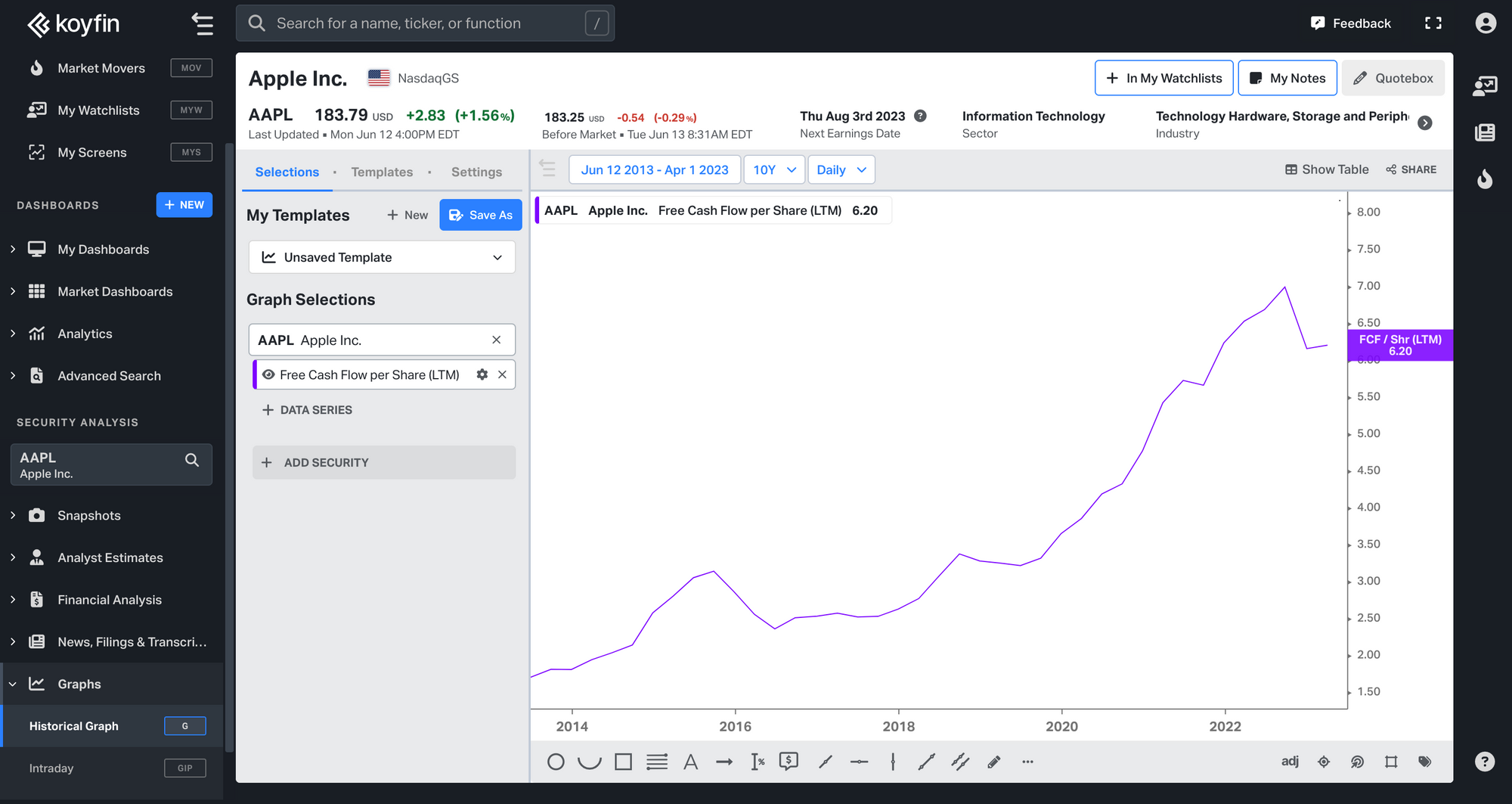
Gross Profit
We use the following formula to calculate Gross Profit:
Gross Profit = Total Revenues - Cost of Revenues
The example below is for Apple Inc. as of September 24, 2022.


Gross Profit Margin %
Gross Profit Margin % is calculated by dividing the gross profit by the total revenues and expressed as a percentage. The formula for calculating Gross Profit Margin % is as follows:
Gross Profit Margin % = Gross Profit / Total Revenues
The example below shows the calculation for Apple Inc. as of September 24, 2022.


Net Debt
Net Debt is a financial metric that measures a company's debt obligations after taking into account its available cash and short-term investments.
Net Debt comprises the following components:
Total Debt
- Total Cash & Short-term Investments
Standard template:
Total Debt
- Total Cash & Short-term Investments
- Long Term Marketable Securities
The following example shows the calculation for Apple Inc. as of September 24, 2022.
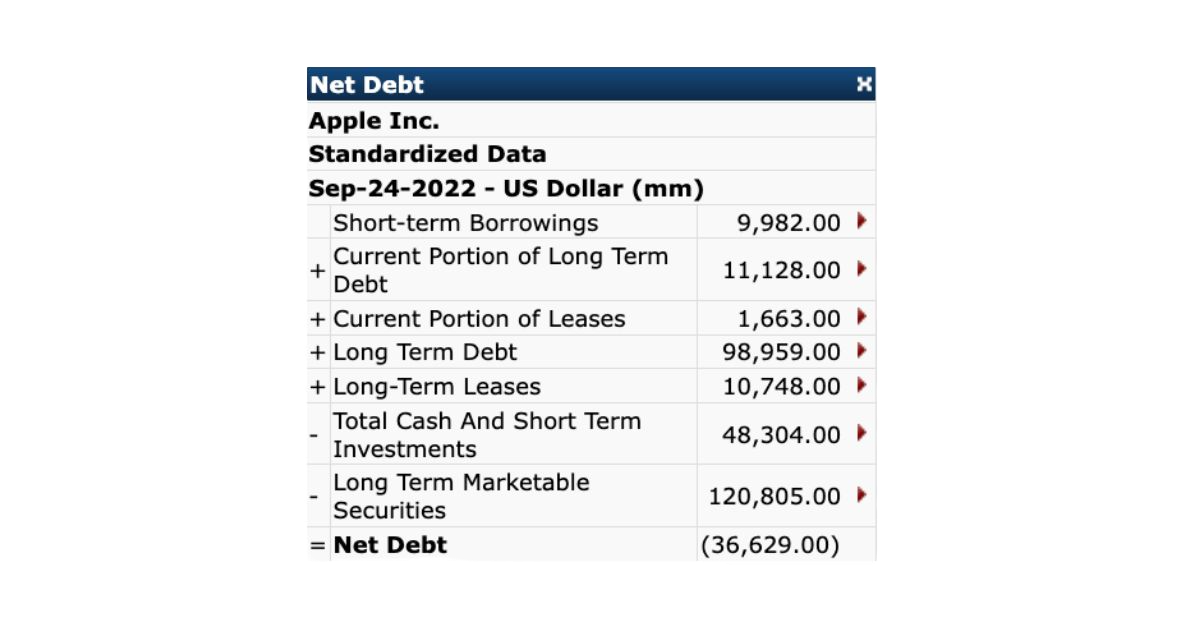
Net Working Capital
Net Working Capital is a financial metric that represents the difference between a company's current assets and its current liabilities. It serves as an indicator of a company's short-term liquidity and operational efficiency, reflecting its ability to cover short-term obligations using readily available resources.
The example below is for Apple Inc. as of September 24, 2022.
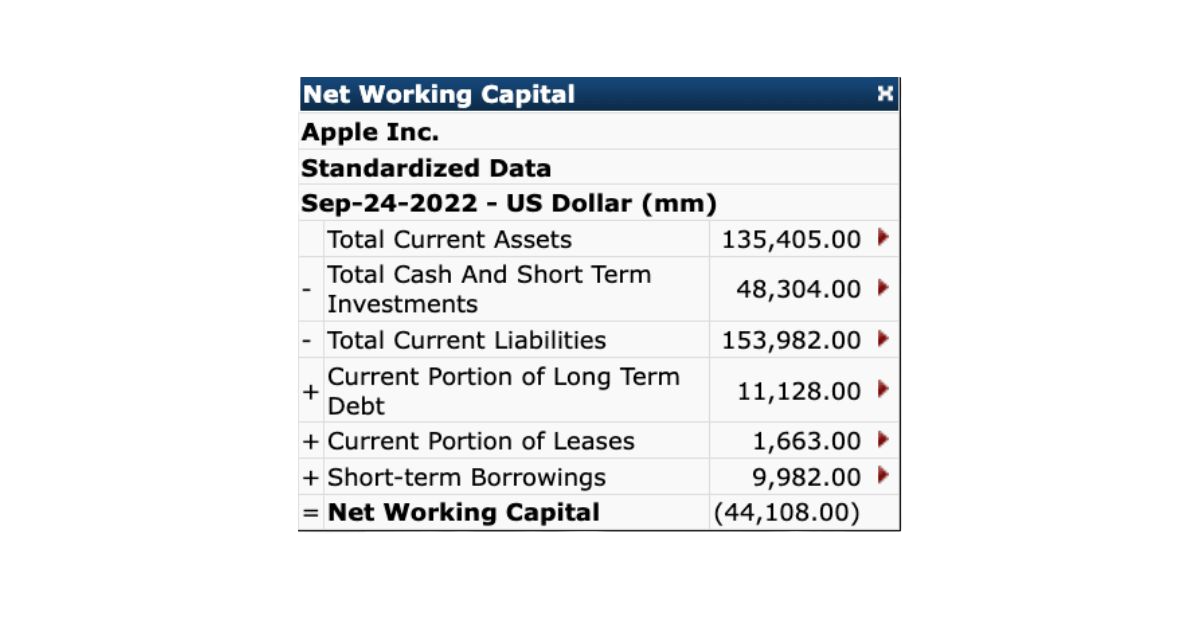
Payout Ratio
The Payout Ratio is calculated using the following formula:
Payout Ratio = Common & Preferred Stock Dividends Paid / Net Income
The example below is for Apple Inc. as of September 24, 2022.

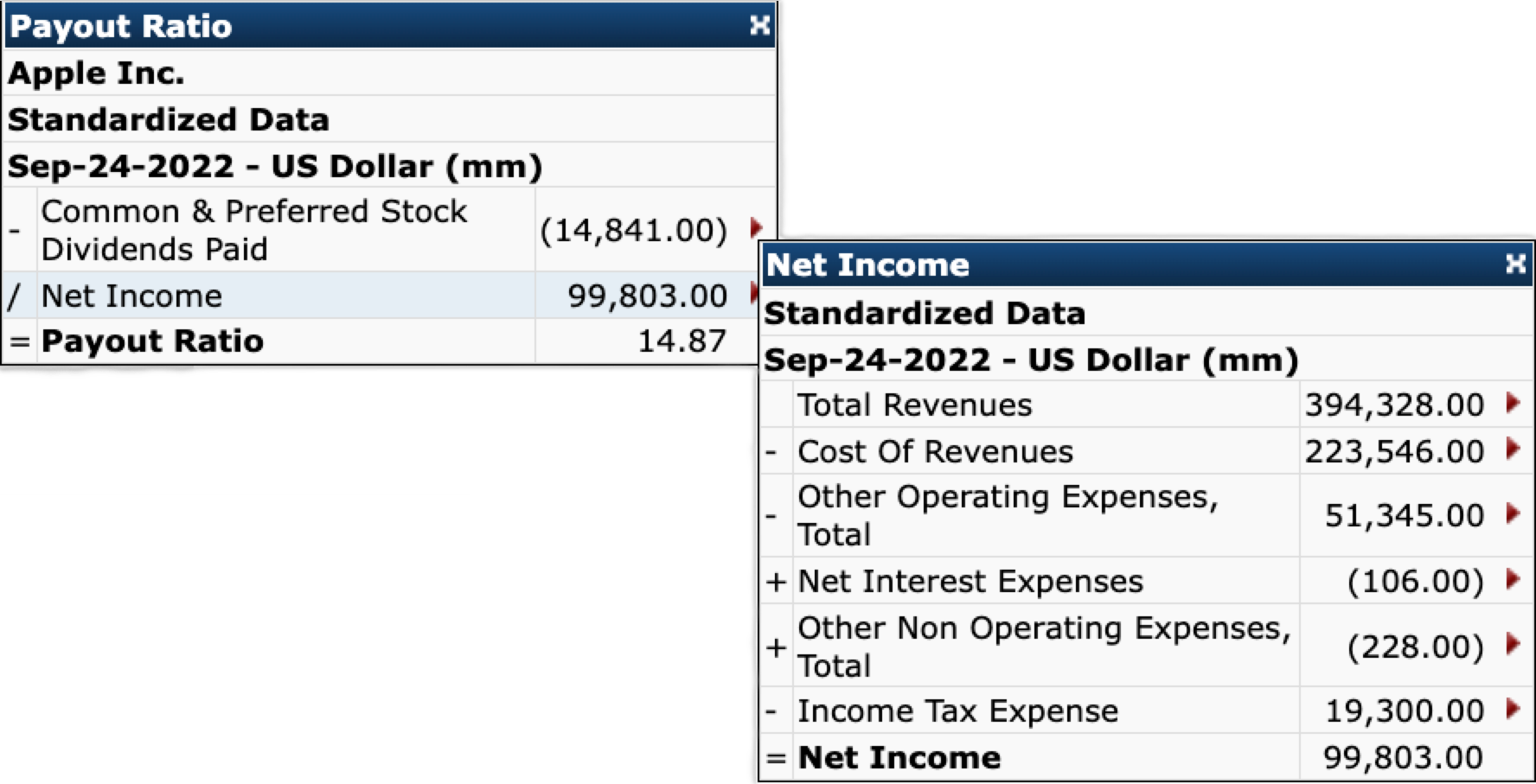
Price / Earnings (LTM)
We use the following formula to calculate the Price / Earnings (LTM) ratio:
Price / Earnings (LTM) = Stock Price / Diluted EPS before extra
The EPS used in this calculation is a GAAP value reported by the company.
The example below is for Apple Inc. as of March 9, 2023.

Price / Earnings (NTM)
To calculate the Price / Earnings (NTM) ratio, we use the following formula:
P/E (NTM) = Stock Price / NTM EPS Mean Estimate
The EPS used in this calculation is Pro Forma and excludes certain accounting expenses like options.
The following example shows the calculation for Apple Inc. as of March 9, 2023.
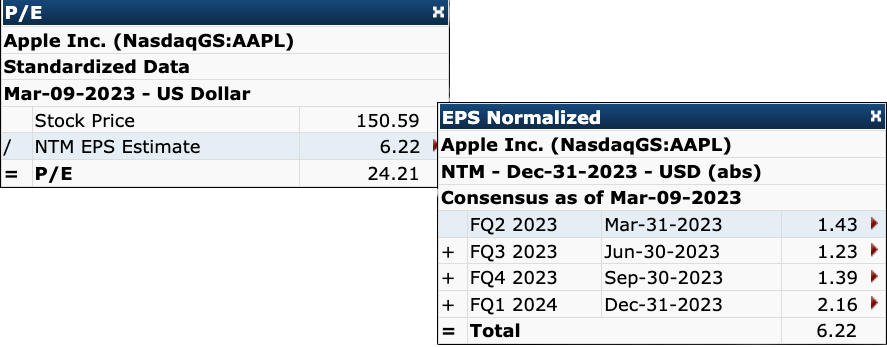
Return on Assets %
We calculate Return on Assets % by using the following formula:
Return on Assets % = (EBIT * 0.625) / ((Total Assets (t) + Total Assets (t-1)) / 2)
The example below is for Apple Inc. as of April 1st, 2023.

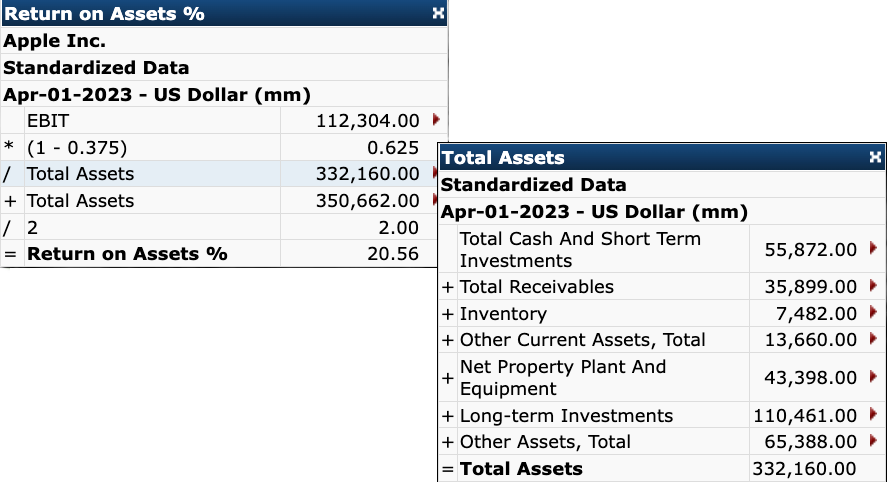
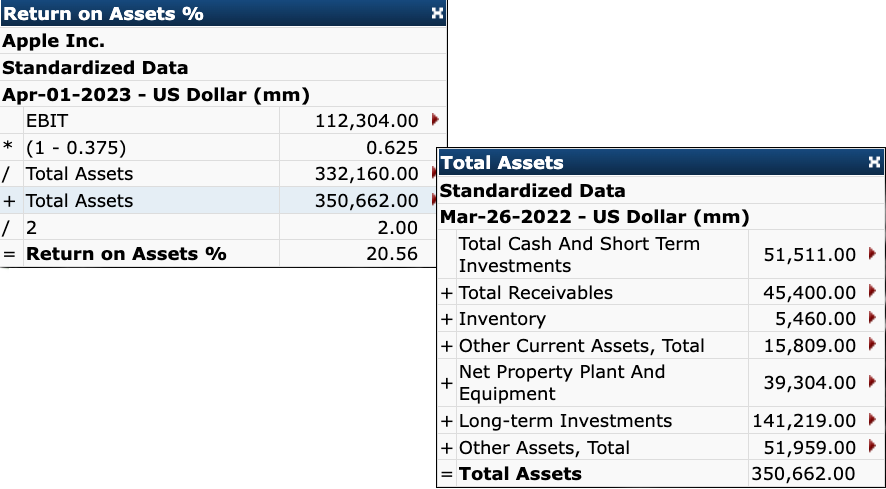
Return on Capital %
We use the following formula to calculate Return on Capital %:
Return on Capital % = EBIT * (1-tax rate) / ((Total Capital (t) + Total Capital)(1-t))/2)
The following example shows the calculation for Apple Inc. as of April 1st, 2023.

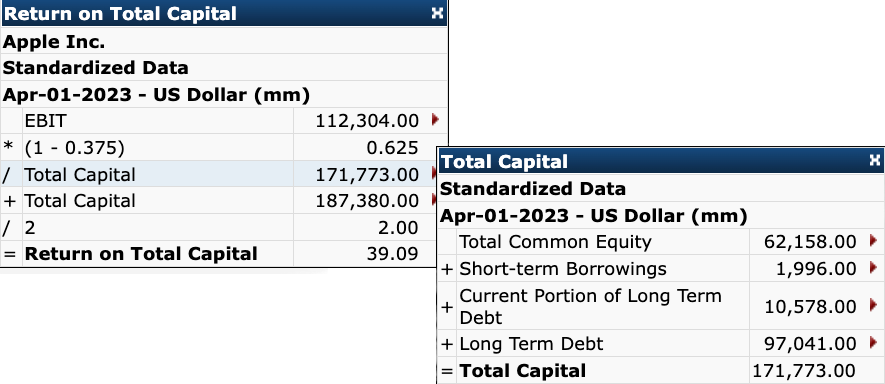
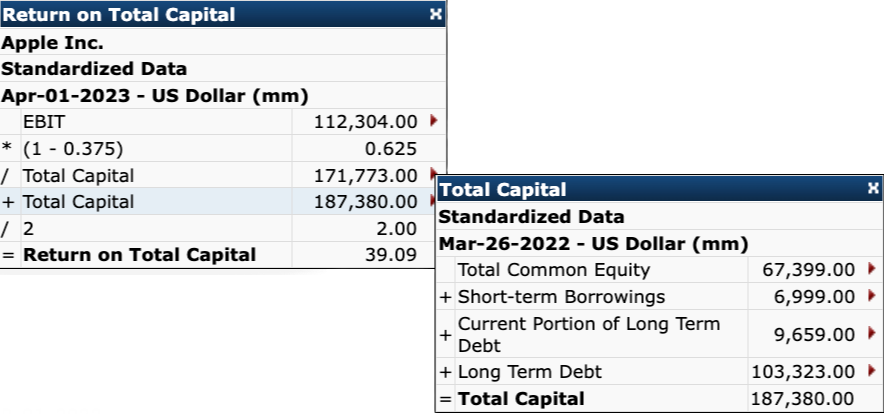
Return on Equity %
To calculate Return on Equity %, we use the following formula:
Return on Equity % = Earnings From Continuing Operations / ((Total Equity (t) + Total Equity (t-1)) / 2)
The example below is for Apple Inc. as of April 1st, 2023.



Return on Invested Capital (ROIC)
ROIC is calculated using the following formula:
ROIC = NOPAT / Average Invested Capital
Where;
NOPAT = EBIT less income tax expense.
Invested Capital = (Long-term debt + short-term debt + shareholder equity + current leases + long-term leases)
Average Invested Capital = (Invested Capital Y0 + Invested Capital Y-1) / 2
RSI
RSI is calculated using the following formula:
RSI = 100 – (100 / [1 + {14-Day Average Gain / 14-Day Average Loss}])
You can use our My Screens functionality to screen for stocks based on their RSI values. To do this, create a new screen and add RSI as a criterion.

Total Current Liabilities
Total Current Liabilities is an essential financial indicator that provides valuable insights into a company's short-term financial obligations. It is a subtotal line item in the standard financial template and consists of various components.
Standard template:
Accounts Payable, Total
Accrued Expenses, Total
Short-term Borrowings
Current Portion of Long Term Debt/Capital Leases
Finance Division Debt Current
Finance Division Other Current Liabilities, Total
Other Current Liabilities, Total
The following example shows the calculation for Apple Inc. as of September 24, 2022.
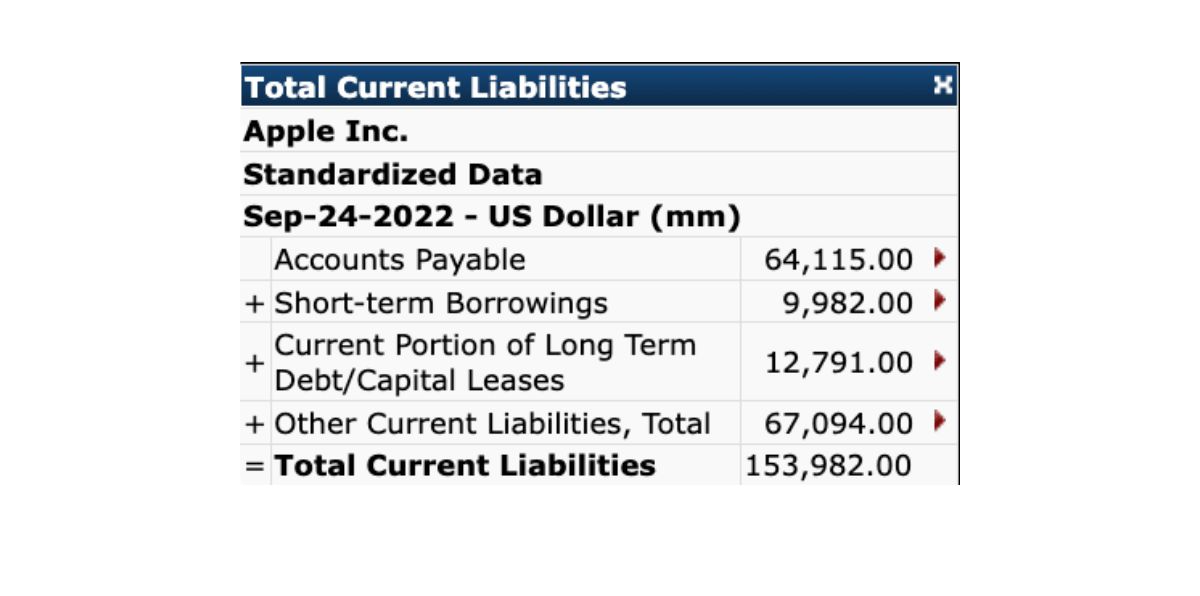
Total Debt
Total Debt is a financial metric that measures the total amount of money a company owes to its creditors.
Total Debt consists of the following components:
Short-term Borrowings
Current Portion of Long-Term Debt
Current Portion of Leases
Long-Term Debt
Long Term Leases
Finance Div. Debt Current
Finance Div. Debt Non-Curr.
The example below is for Apple Inc. as of September 25, 2021.
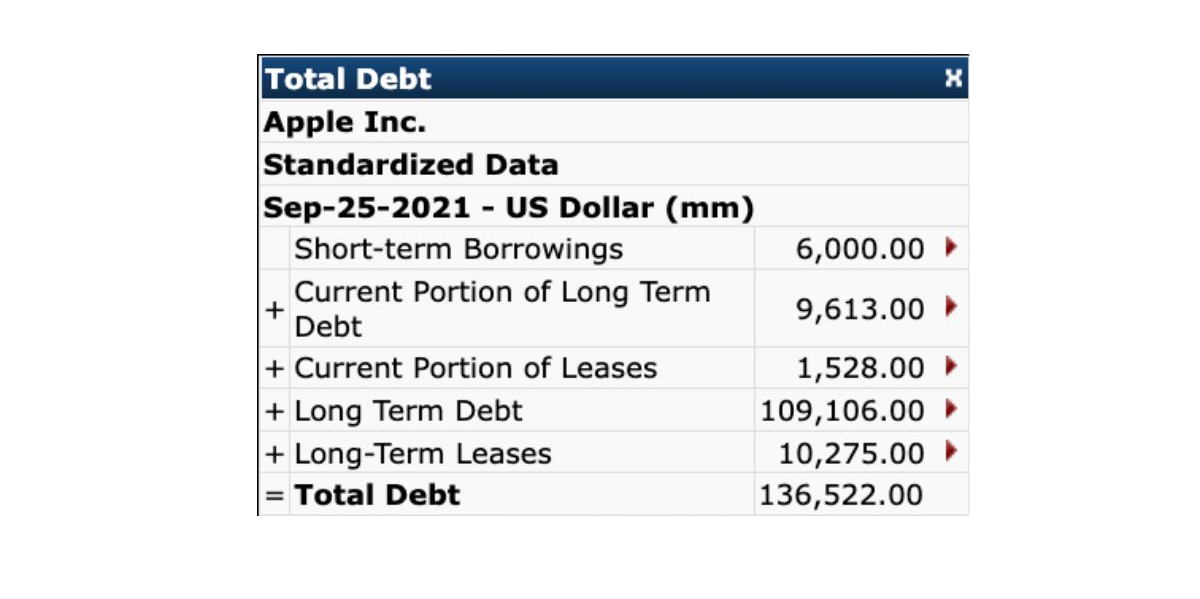
Total Return and Price Change %
Total Return is a metric that captures the full impact of dividends on the value of a stock or ETF, beyond just the changes in its market price. It is derived using the "adjusted price," a figure that adds dividends back to the stock's price at each distribution point, under the assumption these dividends are reinvested. This calculation combines the stock's Price Change and dividend payments to give a complete picture of its performance.
In Koyfin, Total Return can be analyzed using various features such as watchlists, graphs, and screeners.
The Historical Price Graph (G) displays both the Price Change and Total Return percentages as separate data series, allowing for a side-by-side comparison.
The Normalized Performance Graph (GM) shows the percentage change that represents the Total Return, calculated from the stock's or ETF's adjusted price history.
However, it's important to note that Koyfin does not compute Total Return for equity indices like the SPX, where the Normalized Performance Graph only displays Price Changes, excluding dividends. For an analysis inclusive of Total Return on an index similar to the SPX, the SPY ETF is a recommended alternative.
You can read more about Adjusted vs. Unadjusted prices here.
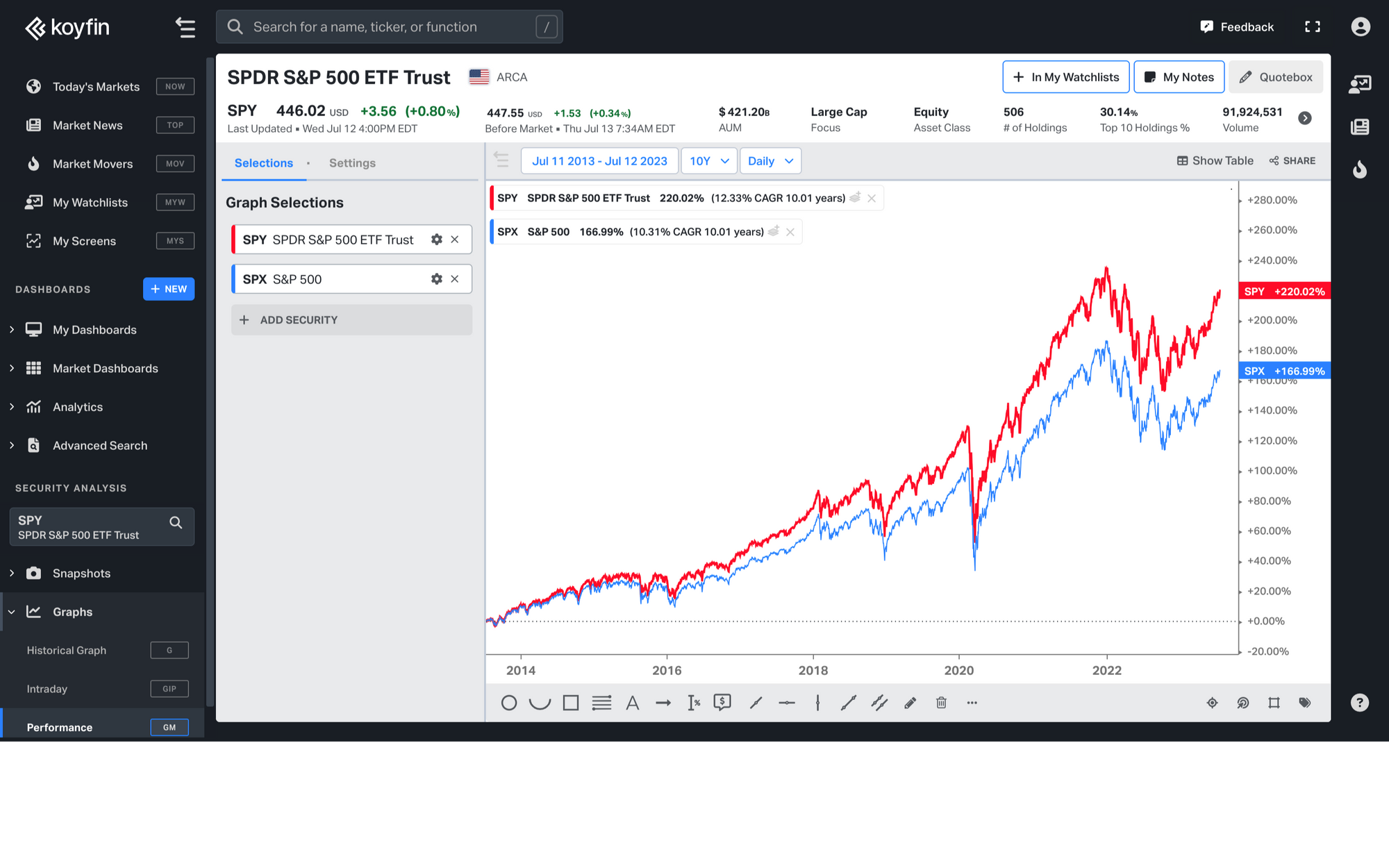
Total Revenues, CAGR
The Total Revenues, CAGR data series shows the historical annualized growth rate:
- 5 FY: CAGR of the latest fiscal year vs. the FY 5 years ago.
- 1 FQ: CAGR of the latest fiscal quarter value vs. the FQ 5 years ago.
- 1 TTM: CAGR of the trailing 12-month value vs. the trailing 12-month value 5 years ago.
The calculation for Apple Inc.'s Total Revenues, CAGR as of September 24, 2022, is shown below.


To visualize the Total Revenues, CAGR of a company, you can refer to the G chart. The graph below provides an illustration of Total Revenues, CAGR values for Apple Inc., including 1Y TTM, 1Y FQ, and 5Y FY.
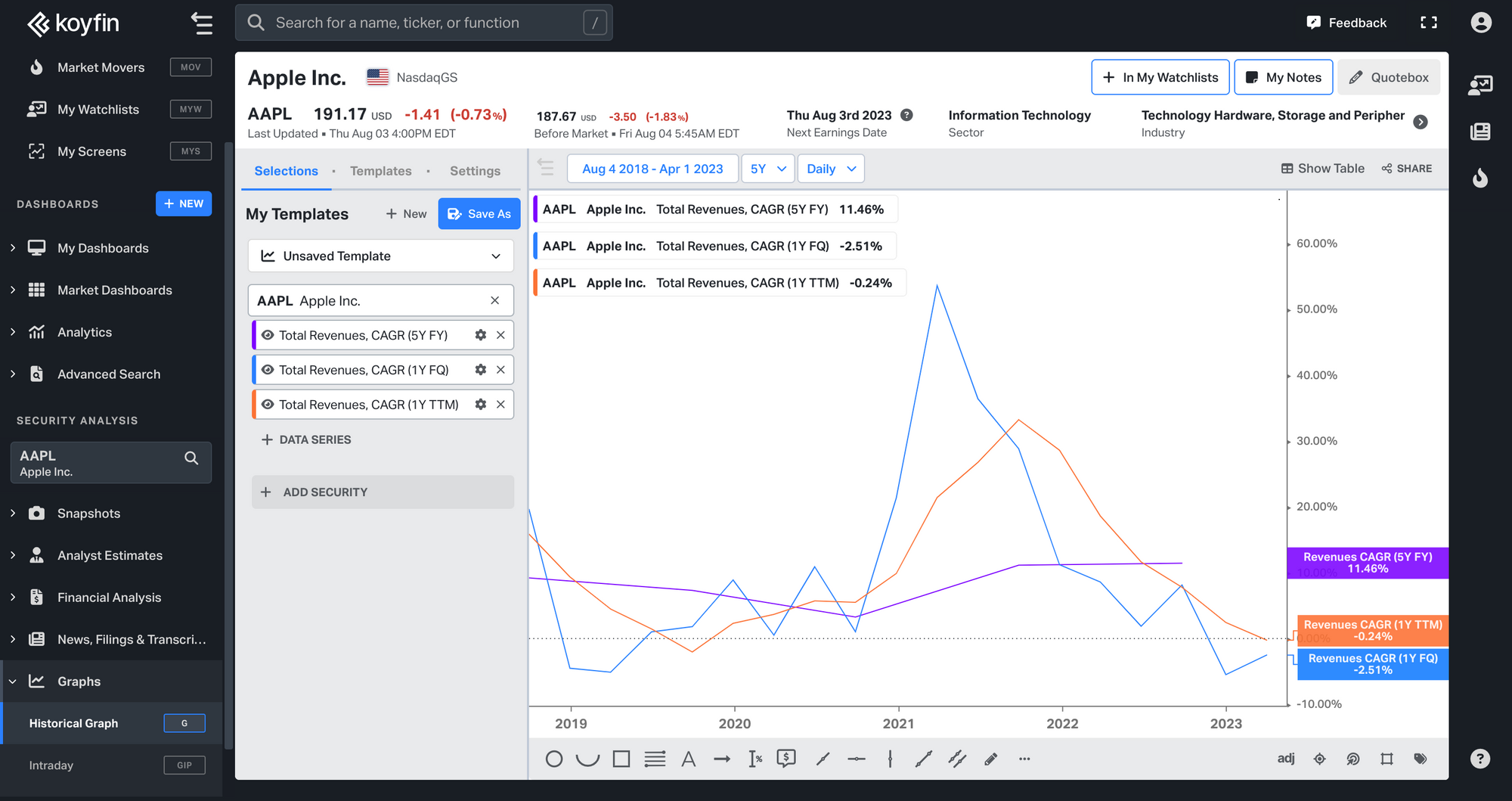
Volatility
Volatility is a measure of the statistical dispersion of the log returns for a given security or market index.
It is calculated as the standard deviation of the log price changes. You can take a look at this example sheet for more information.
You can add a column for Volatility in My Watchlists. The Volatility column will display the realized volatility over a specified period.
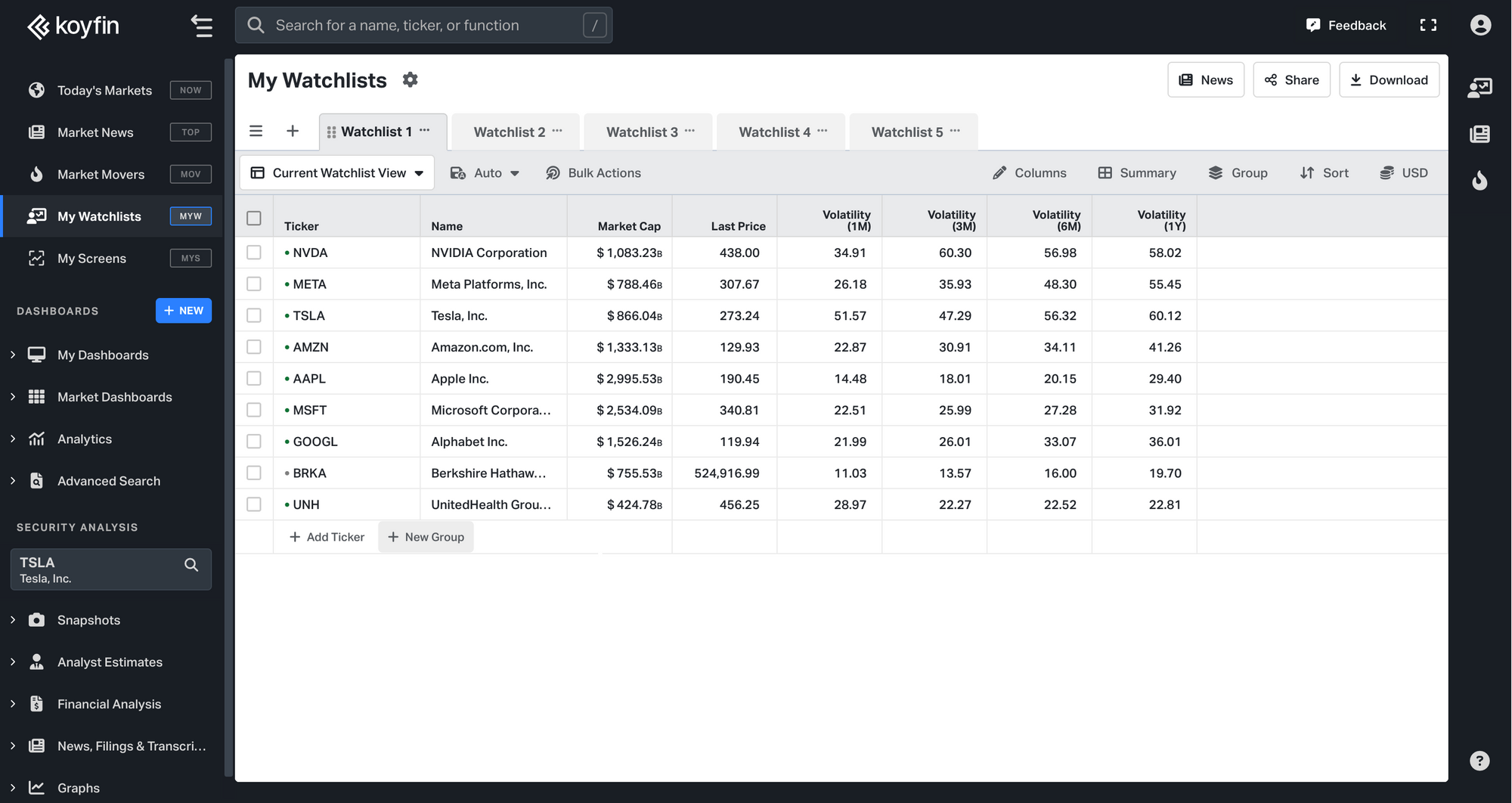
Volume
Volume, Average
The Average Volume is the average number of Shares that are traded on a daily basis over the last 10 days of trading.
Volume, Notional Value
It is the $ amount (or other currency) which we calculate by multiplying Shares * Price.
Volume, Shares
The Volume is the number of Shares.
You can add the columns for Volume, Average, Volume, Notional Value, and Volume, Shares to your watchlist on Koyfin.
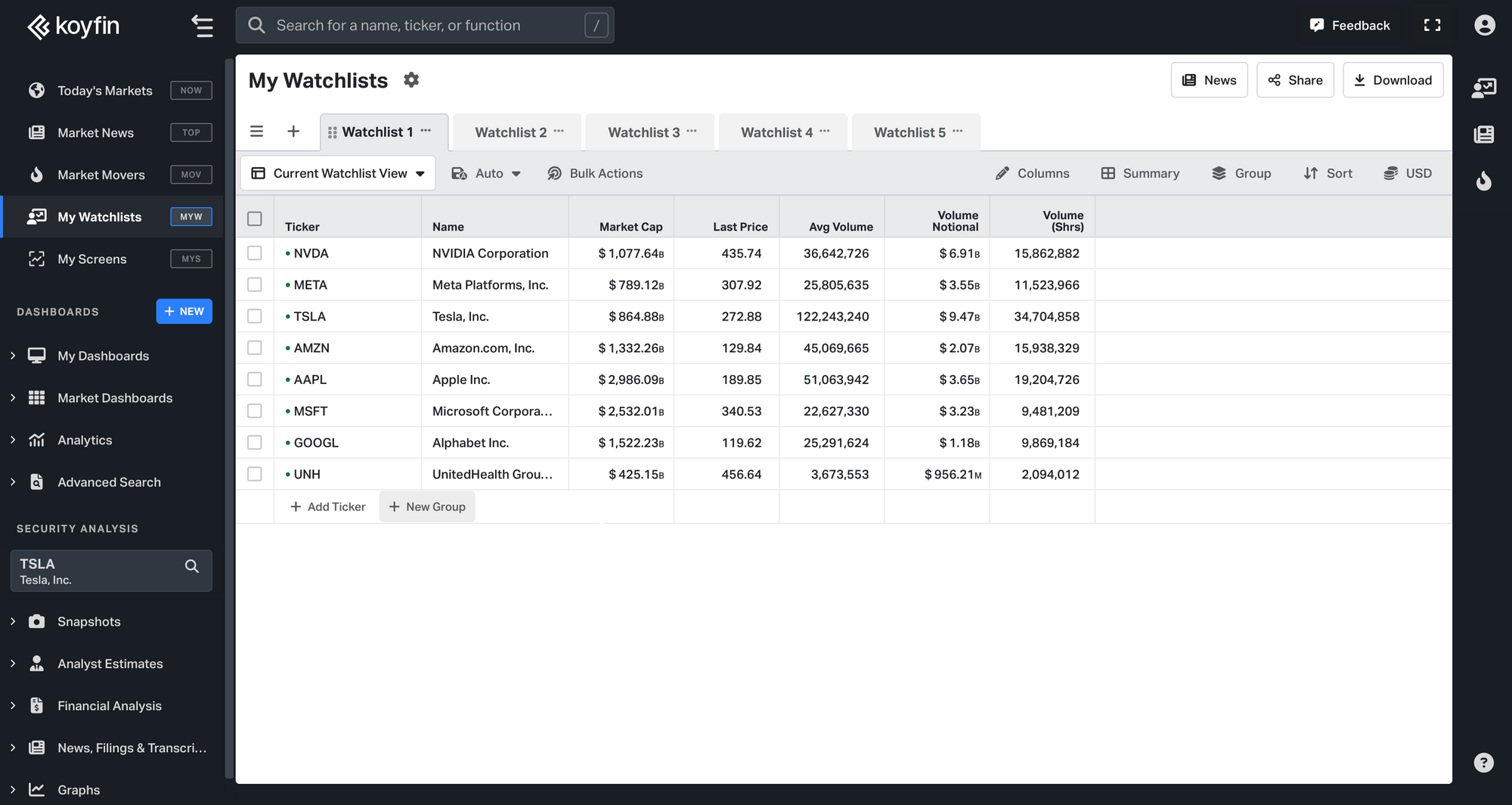
Z-Score
The Z-Score is calculated by dividing the 1D % Change by the Trailing 1-year Volatility. A Z-Score of 1 means the % Change today is equal to 1 Standard deviation relative to the past 1 year of daily Price change.
If you're interested in monitoring the Z-Score for various securities, you can add it as a column to your watchlist.
